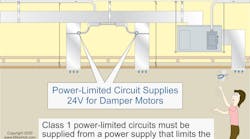Article 725 provides the requirements for Class 1 circuits in Part II. A Class 1 circuit is that portion of the wiring between the overcurrent protective device (OCPD) of a Class 1 power supply and the load [Art. 100 definition]. There are two types:
Class 1 power-limited circuits, which must be supplied from a power supply that limits the output to 30V with no more than 1,000VA [Sec. 725.41(A)] (Fig. 1).Overcurrent protection
Overcurrent protection for conductors 14 AWG and larger must be sized for the conductor ampacity required by Sec. 110.14(C)(1) and Table 310.16. Overcurrent protection for 18 AWG conductors must not exceed 7A. For 16 AWG conductors, overcurrent protection must not exceed 10A [Sec. 725.43].
Locate OCPDs where the protected conductor receives its supply [Sec. 725.45(A)].
Class 1 circuit conductors supplied by a transformer having only a 2-wire secondary can be protected by the primary OCPD per Sec. 450.3(B), if the primary OCPD does not exceed the value determined by multiplying the secondary conductor ampacity by the secondary-to-primary transformer voltage ratio [Sec. 725.45(D)].
Wiring methods
Class 1 circuits must be installed per Part I of Art. 300. Class 1 wiring must be installed in a suitable Chapter 3 wiring method [Sec. 725.46].
You can install two or more Class 1 circuits in the same cable, enclosure, or raceway if all conductors are insulated for the maximum voltage of any conductor [Sec. 725.48(A)].
You can install Class 1 circuits:
- In the same cable, enclosure, or raceway with power-supply circuits if the powered equipment is functionally associated with the Class 1 circuit [Sec. 725.48(B)(1)].
- With the conductors of electric light, power, non-power-limited fire alarm, and medium power network-powered broadband communications circuits where separated by a barrier [Sec. 725.48(B)(1)]. This is new with the 2020 revision.
Circuit conductors and raceway
You can install conductors 18 AWG and 16 AWG within a raceway, enclosure, or listed cable if they do not supply a load that exceeds the ampacities in Table 402.5 [Sec. 725.49(A)]. Conductors 14 AWG and larger must meet the ampacities in Table 310.16. Class 1 circuit conductors must have an insulation rating of at least 600V [Sec. 725.49(B)].
General requirements
Class 1 circuits must also comply with the general requirements of Art. 725, Part 1 [Sec. 725.35], and so must Class 2 and Class 3 circuits, which we will discuss in the December 2020 issue.
Article 725 contains the requirements for remote-control, signaling, and power-limited circuits that are not an integral part of a device or utilization equipment [Sec. 725.1].
These circuits have electrical power and voltage limitations that differentiate them from electrical power circuits. They have alternative requirements for minimum conductor sizes, overcurrent protection, insulation, and wiring methods and materials.
These circuits and their equipment must also comply with the articles or sections listed in Sec. 725.3(A) through (P). Only those sections of Art. 300 that are referenced here apply. Note that Sec. 725.3(L) through (O) address Class 2 and Class 3 circuits, not Class 1 circuits. In other words, when installing Class 1 circuits, you must apply Sec. 725.3(P) and (A) through (K) but when installing Class 1 or Class 2 circuits, you must apply Sec. 725.3(A) through (P).
Raceways must be large enough to permit the installation and removal of conductors without damaging conductor insulation, as limited by Sec. 300.17 [Sec. 725.51(A)].
When all conductors within a raceway are the same size and insulation, you can find the permitted number of conductors in Annex C for the raceway type [Chapter 9, Notes to Tables, Note 1].
For conductors not included in Chapter 9 (e.g., multiconductor cable), use the actual dimensions. If running one multiconductor cable in a raceway, use the single conductor percentage fill area [Chapter 9, Notes to Tables, Note 5 and 9]. These conductors are subject to the ampacity adjustment factors in Sec. 310.15(C)(1) only if they carry continuous loads in excess of 10% of conductor ampacity.
Installation of Class 1, 2, and 3 circuits must comply with Sec. 300.21 [Sec. 725.3(B)]. Electrical circuits and equipment must be installed in a way that does not substantially increase the spread of fire or products of combustion. Openings into or through fire-resistive walls, floors, and ceilings for electrical equipment must be firestopped using methods approved by the authority having jurisdiction (AHJ) to maintain the fire-resistance rating of the fire-resistive assembly [Sec. 300.21].
Boxes installed in fire-resistive assemblies must be listed for that purpose. If steel boxes are used, then they must be secured to the framing member; thus, cut-in type boxes are not permitted (UL White Book, Guide Information for Electrical Equipment).
Class 1, Class 2, and Class 3 circuits installed in ducts or plenums must comply with Sec. 300.22 [Sec. 725.3(C)].
Exception No. 1: Class 2 cables selected per Table 725.154 and installed per Sec. 725.135(B) and Sec. 300.22(B), Exception, can be installed in ducts specifically fabricated for environmental air.
Exception No. 2: Class 2 cables selected per Table 725.154 and installed per Sec. 725.135(C) can be installed in plenum spaces.
Class 1, Class 2, and Class 3 circuits installed in hazardous (classified) locations must comply with Sections 501.10(B)(1), 501.150, 502.10(B)(1), 502.150, 503.10(A)(1), 503.150, 506.15(A), 506.15(C), 511.7(B)(1), 515.7(A), and Art. 517, Part IV [Sec. 725.3(D)].
Class 1, 2, and 3 circuits in cable trays must be installed per Parts I and II of Art. 392 [Sec. 725.3(E)].
If a raceway is subjected to different temperatures where condensation is a known problem, fill the raceway with a material approved by the AHJ to prevent the circulation of warm air to a colder section of the raceway in accordance with Sec. 300.7(A) [Sec. 725.3(H)].
When using a raceway for the support or protection of cables, use a fitting where the cables enter the raceway per Sec. 300.15(C) [Sec. 725.3(J)].
Equipment grounding conductors must be identified per Sec. 250.119 [Sec. 725.3(P)].
Exception: Conductors with green insulation can be used as ungrounded signal conductors for Types CL3P, CL2P, CL3R, CL2R, CL3, CL2, CL3X, CL2X, and substitute cables installed per Sec. 725.154(A).
Safety-control equipment
Circuits used for safety-control equipment must be classified as Class 1 if the failure of the remote-control circuit or equipment introduces a direct fire or life hazard [Sec. 725.31(A)] (Fig. 3).If damage to remote-control circuits of safety-control equipment would introduce a hazard [Sec. 725.31(A)], then conductors must be installed in rigid metal conduit, intermediate metal conduit, PVC conduit, electrical metallic tubing, Type MI cable, or Type MC cable. Or, they must be otherwise suitably protected from physical damage [Sec. 725.31(B)].
Repeated general requirements
The following general requirements also appear in several other places in the NEC, in one form or another.
You can’t let an accumulation of cables prevent the removal of suspended-ceiling panels for equipment access [Sec. 725.21].
Equipment and cabling must be installed in a neat and workmanlike manner [Sec. 725.24].
Exposed cables must be supported by the structural components of the building so the cable will not be damaged by normal building use. Support must be by straps, staples, hangers, cable ties, or similar fittings designed and installed in a manner that will not damage the cable. The installation must comply with Sec. 300.4(D).
Cables installed through (or parallel to) framing members or furring strips must be protected where they are likely to be penetrated by nails or screws. Install the wiring method so it is at least 1¼ in. from the nearest edge of the framing member or furring strips or protect it with a 1⁄16-in.-thick steel plate or equivalent [Sec. 300.4(A) and (D)].
Informational Note: Avoid contamination. Paint, plaster, cleaners, abrasives, corrosive residues, or other contaminants can result in an undetermined alteration of Class 1, Class 2, Class 3, and PLTC cable properties.
Class matters
Class 1, Class 2, and Class 3 circuits don’t fall under Chapter 3 requirements except as specifically mentioned by Sec. 725.3. Thus, for Class 1 circuits, look there and in Part I and Part II so you know what’s required.
Class 2 and Class 3 circuits have different requirements from the ones we just discussed, and those are presented in Part III. In the December issue, we will look at those requirements.
These materials are provided to us by Mike Holt Enterprises in Leesburg, Fla. To view Code training materials offered by this company, visit www.mikeholt.com/code.








